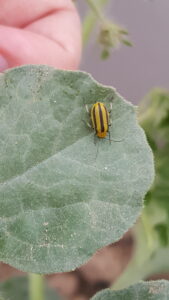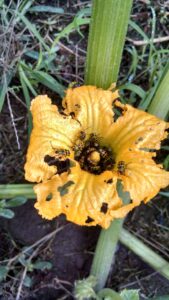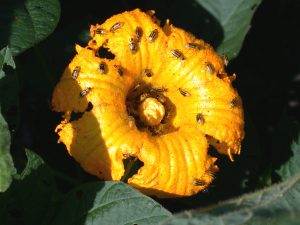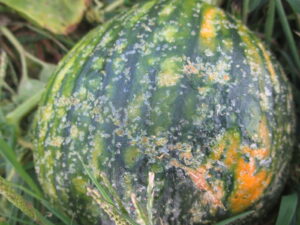This time of year you are likely getting bogged down in the fight against pests. The accumulation of plant pathogens, insects, and climatic conditions favoring their growth can make the last few weeks of harvest feel like the toughest point in the battle. For cucurbit growers in particular, there are a number of insect pests that are quite a nuisance. Three different beetle species are likely honing in on your ripening fruits and they may cause some significant aesthetic damage to the rind of your pumpkins, melons, and squash. This damage can also provide an entry to secondary pathogen infections that may destroy your crop. The culprits are the striped cucumber beetle (Acalymma vitattum; Figure 1), the spotted cucumber beetle (Diabrotica undecimpunctata; Figure 2), and the Western Corn Rootworm (Diabrotica virgifera virgifera; Figure 3). The bacterial pathogen that these beetles can transmit is no longer something to worry about, so close to harvest. But their feeding damage may be (Figure 4). At this point, pests are concentrating on the resources at hand. The striped cucumber beetles that you are seeing will find a cozy place to overwinter across the state, often in field margins, ditches or perhaps even forest edges. The spotted beetles will die off and have to make their journey north all over again next year. As for the corn rootworm, they will leave your veggies alone and move back to their preferred host next year. They are not nearly as numerous in our vegetable crops and honestly we don’t know much about how they impact them. We do know how to manage them in our field crops though (but you will have to talk to a different Entomologist about that one, I can share his number!).
What can you do?
I would like to answer with harvest what you can and leave a few to the beetles, but I know that is unsatisfactory and not helpful at all. If your crop is going to be in the field much longer and you are concerned about economic loss as a result of their feeding, then be sure to look closely at the pre-harvest interval (PHI) when selecting an insecticide. Exposure of pollinators is also something that needs to be considered. While you will not be harvesting from the flowers that are open in the field right now, they are still a valuable resource for pollinators. For a more complete list of your options check out the Midwest Vegetable Production Guide (mwveguide.org). Some products include Harvanta® (PHI: 1-d), Mustang Maxx® (PHI: 1-d). To decrease the exposure of pollinators to any of the products you may apply, do so late in the day/evening when flowers are closed and bees are not as active.



